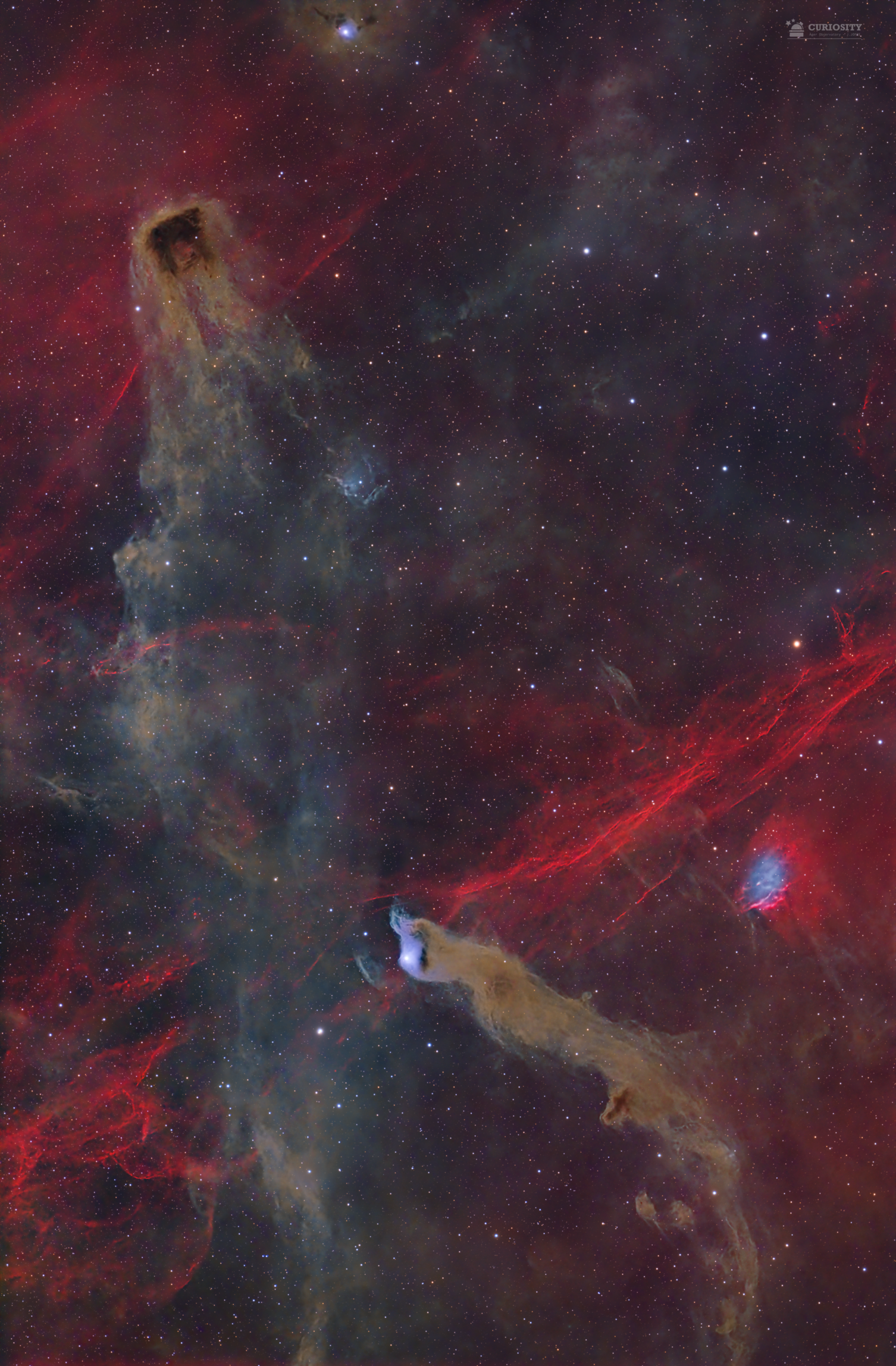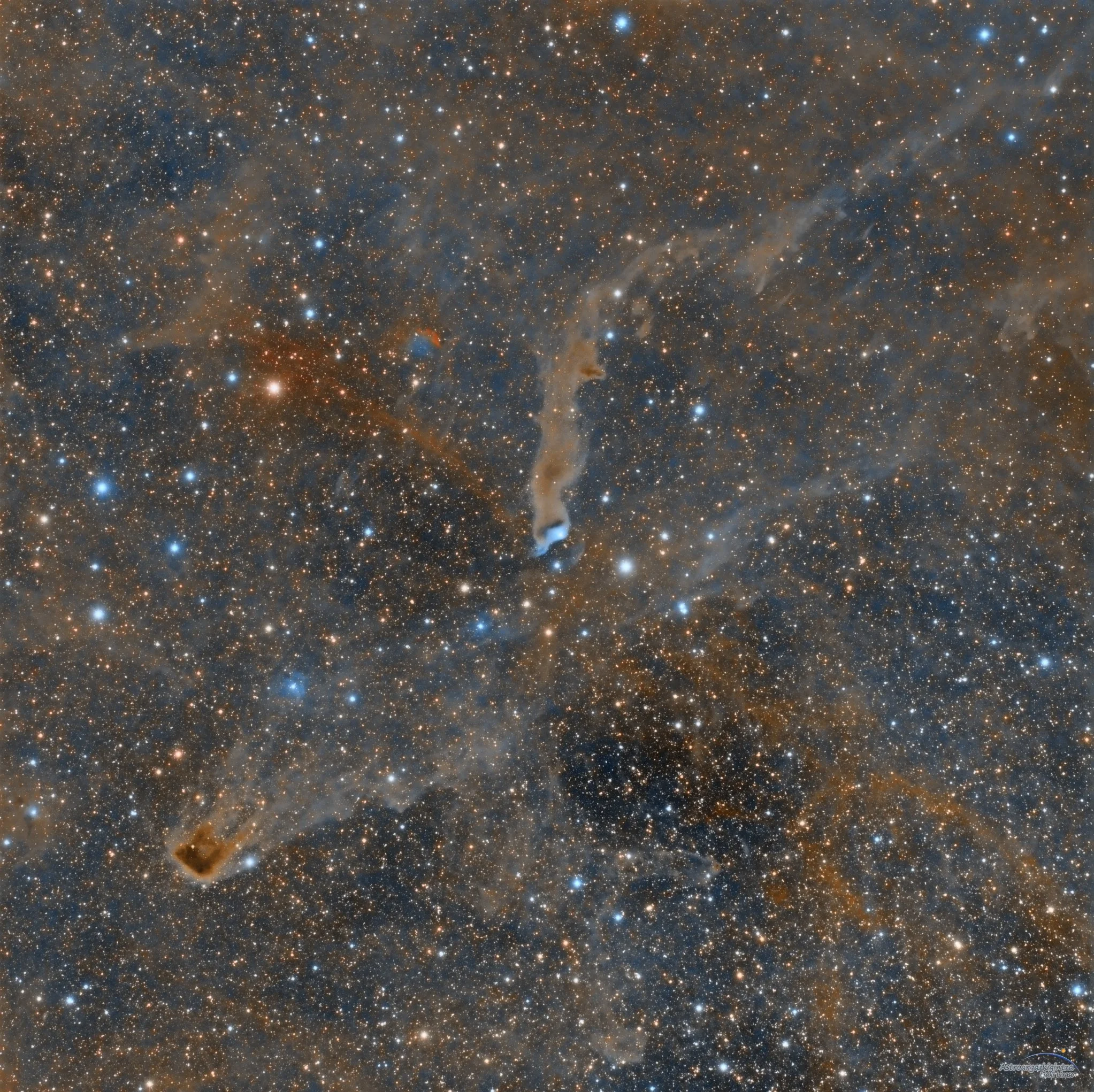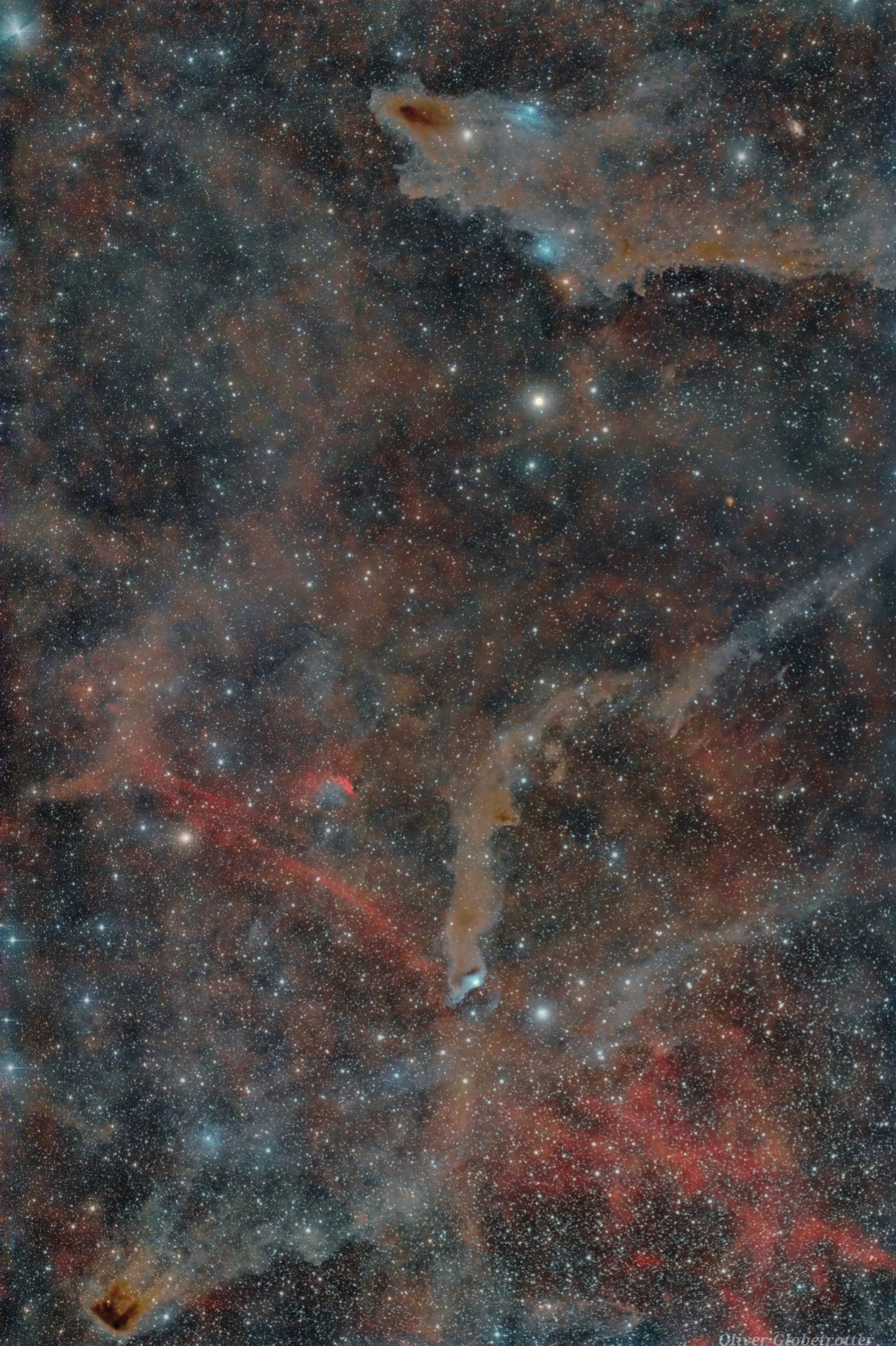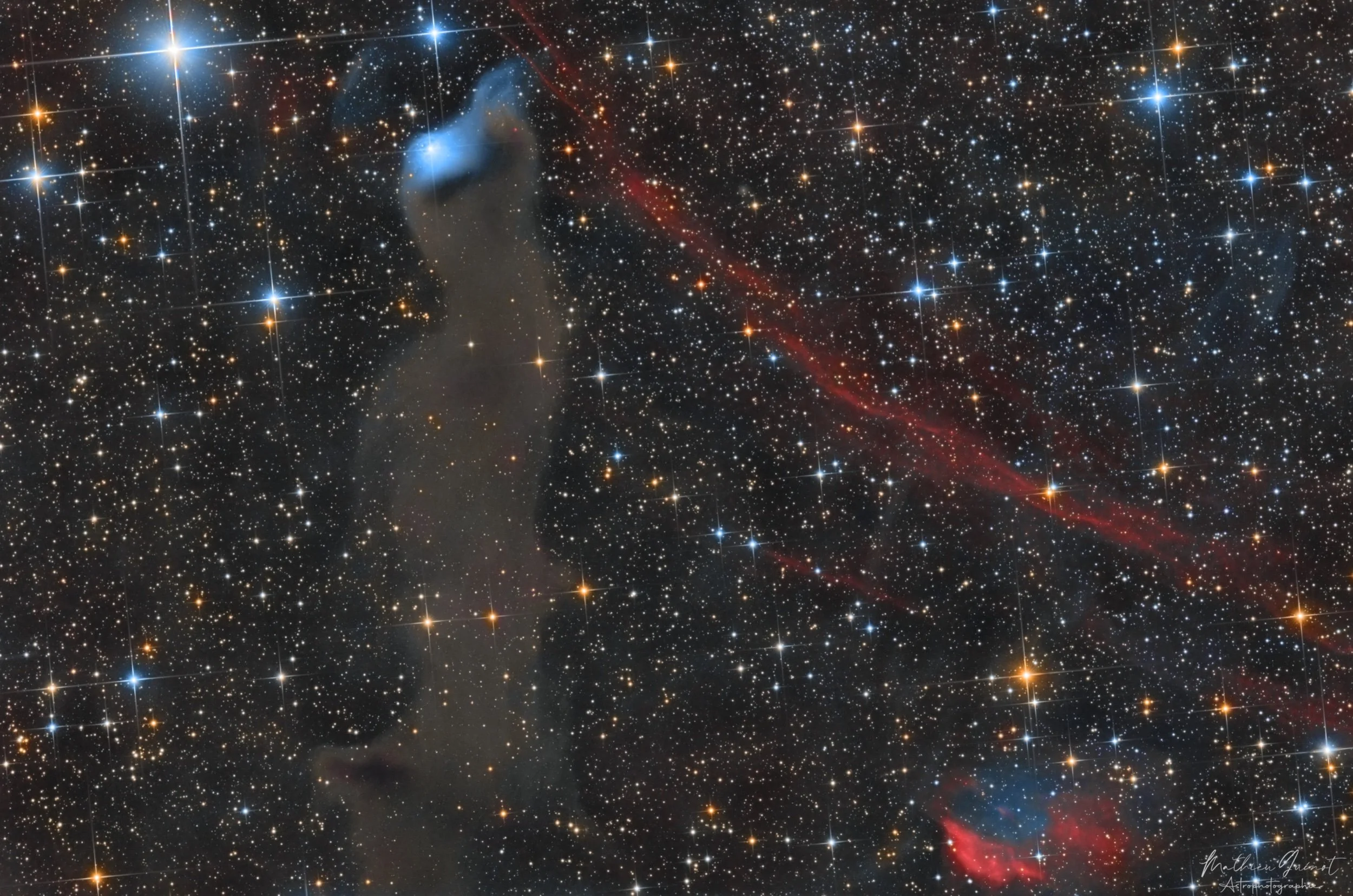
AAPOD2 Image Archives
Vdb 152
VdB 152, also known as the Wolf's Cave Nebula, is a stunning reflection nebula nestled in the constellation Cepheus, approximately 1,400 light-years away. This delicate structure appears as a faint, bluish glow caused by starlight reflecting off surrounding interstellar dust. The nebula is part of a dense molecular cloud that obscures the light from background stars, creating a dramatic interplay of light and shadow.
Captured from southern Portugal over 24 hours in LRVB, Hα, and OIII, this long exposure reveals the nebula's faint, ethereal features. Intricate filaments of hydrogen-alpha and oxygen-III emissions enhance the view, showcasing regions of subtle ionization and interstellar activity. The nickname "Wolf's Cave" evokes its mysterious, enclosed appearance, where light seems to emerge from the darkness, illustrating the quiet beauty of cosmic processes shaping the galaxy.
The Wolf's Cave and the Toast Nebula
This remarkable region in the constellation Cepheus showcases a tapestry of astrophysical phenomena, where stars and interstellar matter come together to create a scene of cosmic artistry. Each of these designations represents distinct features within a vast complex of gas and dust, woven into the fabric of our galaxy.
VdB 152, also known as Ced 201, is a faint reflection nebula perched at the tip of an elongated dark nebula. It gleams with a ghostly blue hue as it reflects the light from nearby stars, offering a stark contrast to the surrounding inky darkness.
LDN 1221 is part of a dense dark nebula obscuring background starlight, forming intricate, sinuous shapes that add depth and mystery to the region.
LBN 534 and LBN 538 are large, faint emission nebulae that provide the backdrop, glowing faintly in hydrogen-alpha emissions, highlighting the presence of ionized gas.
This area is a rich hunting ground for amateur and professional astronomers alike. The interplay of light and shadow reveals the ongoing processes of star formation, with dark filaments of dust punctuated by the glow of emerging stars. The complex structures speak to the dynamic interactions between gravity, stellar winds, and radiation.
Imaged under the pristine skies of a dark-sky location, this celestial mosaic serves as a reminder of the quiet yet awe-inspiring forces that shape the universe. In Cepheus, beauty and complexity converge in an astronomical masterpiece.
VdB 152 Capercaillie Nebula
Behold the mesmerizing beauty of VdB 152, the ethereal Capercaillie Nebula! This celestial masterpiece showcases an intricate dance of vivid colors and wispy tendrils, as newborn stars illuminate the surrounding cosmic canvas with their radiant brilliance, leaving stargazers awe-inspired and humbled by the wonders of the universe.
VdB 152 and its dusty field
Image Description and Details : Located in the Cepheus constellation at 1400 lights-years, Van den Berg 152 is a blue reflection nebula near the edge of a large molecular cloud with full of interstellar dust and a star in the embedded region (BD+69 1231) giving to the edge of the molecular cloud the blue color. LDN1221 and a large tail of dust crosses the field like a comet. Image acquired through Takahashi FSQ-106EDX3 on EM-200Temma2M and Andor Apogee U16M / AFW-50-7S ccd. Guiding: FS-60CSV, QHY-5, PHDguiding. Processing by PixInsight Core 1.8. Date: 27th of June 2022.
Copyright: Iñaki Lizaso
Ldn 1235 & VDB 152
Image Description and Details:
Here is the last image made with the new Askar 600 scope and the 6d gun! Staying 1 week in Aveyron with the astronomical association I was able to test my new askar 600 telescope, with reducer, I go to 420mm focal length and an aperture of f3.9! Formerly I had a Newton 150 750, f4 it changes bcp! Here is a small image made on Cepheus, if it's done it's over! Here is ldn 1235 the shark and vdb 152 the magic bean from dragon ball z!! Askar 600 with reducer f3.9 Heq5 pro goto Canon 6d iso 1600 defiltered by Photomax Lacerta mgen 3 svbony 60/240 Brutes 100 x 300'' 30 dof Siril, pixinsight, photoshop
Copyright: Olivier Bernard
VdB 152, Barnard 175 & Co
Image Description and Details : Here is a rich field located within the large molecular cloud of Cepheus.
This image was an experiment under my downtown sky, and i am rather happy with the result because, although having probably approached the limits of the Bortle 7 sky, it shows that urban astrophotography still offers possibilities with this type of object.
4 types of nebulae are visible in this image, against a background of nebulosities of interstellar dust:
- the dark nebula Barnard 175, a dense pillar of dust
- the reflection nebula Vdb 152, shining a characteristic blue at the top of this dark pillar
- the old planetary nebula DeHt-5 radiating mainly in the wavelengths of ionized hydrogen and oxygen (red and blue)
- part of the SNR 110.3 + 11.3 supernova remnant whose ionized hydrogen filaments (red) cross the field
Some distant small galaxies are visible in the background despite the density of this area of the Milky Way.
37h30 of exposures carried out in September and October 2021 in Amiens (Bortle 7) through LRVB filters supplemented by H and O filters for NP and supernova remanence with:
newton 250mm f / 3.8
CEM120 mount
Camera ZWO ASI 2600mm
Processing with Pixinsight and Photoshop.
L: 645 x 120s
RGB: 33x120s, 40x120s and 44x120s
H: 85 x 300s
O: 60 x 300s
Copyright: Mathieu Guinot
The pillar of Cepheus (VdB 152)
Image Description and Details :
This cosmic pillar stretches for approximately 1,400 light years along the northern part of the Milky Way, in the constellation Cepheus. Near the edge of the large molecular cloud, pockets of dust block all light from the stars in the background or weaken the light of the brightest star at the top, this star giving the nebula its characteristic blue color.At the bottom right of the image is a planetary nebula LBN 538 (red / blue). Discovered in 1979 and first described in an article in 1980 by Dengel, Hartl and Weinberger.ASA Newton 250/950 F3.6Paramount MyTZWO ASI2400MC à -10°C + rotateur ArteskyIDAS LPS-P3 et IDAS NBZ Nebula BoostSkywatcher Evostar72ED + ASI120MM miniTheSkyX pro, MaxPilot, FocusMax, AstroPixel Processor, PixInsight, Photoshop44h5' (68x 900” Filtre NBZ, 83x300" et 121x600" Filtre LPS-P3)Lorraine, France31 August, 1er, 2, 3, 4, 5, 7 et 8 September 2021
Copyright: Thomas LELU
SNR 110.3 + 11.3, DeHt 5 and vdB 152
Telescope / Mount / Guiding
ASA 10" Astrograph, ASA 3" Wynne-Corrector (focal length 910mm)ASA DDM60, no guiding
Camera / Exposure
Canon 6D
73 x 10min
Moravian G3-16200, Astrodon filters
L 45 x 3min bin 2x2, 41 x 3min bin 2x2 Hα 2 x (21 x 20min) OIII 2 x (18 x 10min) bin 2x2
Total exposure time: 36h 28min
Processing
PixInsight, Fitswork, Photoshop
Notes
This image took me more than 7 years to create. The first time I shot with an unmodified Canon 6D in 2013. But was not satisfied with the data after I had the opportunity to process Frank Sackenheim's CCD data of the same object (here or on Frank's homepage). In 2018 I made attempts with luminance shots in 2x2 binning with a Moravian G3-16200 (due to the bigger sensor of the Canon 6D now as 2 panel mosaic), but I have not continued this project. In summer 2020 I found this old data again, added additional Luminance-data and new Halpha- and OIII-data and finally tried to create an image with these old and new data.
The red streakes crossing the image in diagonal direction are a small part of the huge supernova remnant SNR 110.3+11.3 in the constellation Cepheus. It is one of the nearest supernova remnants and only 1300 light years away from earth. These shocked molecular gas filaments were discovered and catalogued in 2001 by John Bally and Bo Reipurth.
Van den Berg (vdB) 152 is a blue reflection nebula that glows at the bottom of a dark Bok globule called Barnard 175. Near the edge of a large molecular cloud, interstellar dust in the region blocks most of the starlight behind it or scatter light from the embedded bright star giving parts of the nebula a characteristic blue color. Ultraviolet light from the star is also thought to cause a dim reddish luminescence in the nebular dust.
Embedded in the left side of the nebula is the Herbig Haro object HH 450, a jet emitted from a newly forming star.
Dengel-Hartl (DeHt) 5 is a HII- and OIII-region, maybe an ancient planetary nebula, ionized by the white dwarf WD 2218+706 (the blue star in the center of the nebula). Beverly Lynds catalogued the brighter part as LBN 538.
Copyright: Thomas Henne








